Five Easy Ways to Get Back to a Better Bedtime.
Parents who have experienced a lice outbreak in their homes know, lice definitely have an impact on your child’s sleep. Lice are considered nocturnal creatures. They live off of human blood. During the evening hours they become active, crawling around the scalp of their victim searching for places to burrow, lay eggs and eat. Their saliva, fecal matter, and biting creates irritation and itching on the scalp. Imagine the sensation of insects crawling on your head, piercing your scalp and making a home on your head. Not the most sleep provoking scenario, to say the least. After your family is treated and lice free, here are some simple suggestions to getting back into a healthy bedtime pattern.
- Pick an appropriate bedtime and stick to it. The National Sleep Foundation puts out guidelines for sleep required by age. Infants 0-2 years of age need the most sleep with a full 12 hours every night and at least a 2-hour nap during the day. Children 3-6 years also need a full 12 hours of sleep at night, without the daytime nap. When children reach ages 7-12 it is recommended they get 10-11 hours of sleep per night. Teenagers between the ages of 13-18 are still growing and developing, which means they still need at least 8 hours of sleep every night. Choose a bedtime that will help children get the recommended allotment of sleep for their age. Start your daily bedtime routine with plenty of time before they should be asleep. This helps to avoid feelings of scurrying around creating anxiety to meet the bedtime deadline. Avoid late nights that interrupt the pattern and try to keep the schedule as consistent as possible.
- Bathe every night to create a routine. A warm, relaxing bath goes a long way in helping children unwind and start to feel ready for sleep. Bubbles with scented soap or bath oils are a good idea to create a serene environment. Some scents promote feelings of relaxation and sleepiness. These include jasmine, vanilla, lavender and anything else that brings you comfort or makes you feel at home. Continue to prepare for bedtime by keeping an established routine. Brush your child’s teeth, comb their hair or perform any other bedtime preparation in the same order every night.
- Let your child have a comforting object for night time use. Every child has a beloved stuffed animal or a favorite blanket that warms their heart and provides them solace. Allow them to snuggle up at bedtime with their object of choice as a reward for keeping up their routine.
- Play soft music, sing a soothing song, or read a book together. Even older children enjoy reading with their parents. With so many wonderful books to choose from, make it a habit to read together every night. Once in awhile tell children a story from your childhood or make up fun stories together. Unwinding with a quiet lullaby, a sweet story or some peaceful music can help to put their minds at ease and get them in the mood to sleep soundly.
- Spend one on one time, even if for a few moments. Taking a few minutes each night to talk to your child is a powerful tool. Offer an uplifting compliment, pay attention to something that may be worrying them, or tell them something encouraging you noticed they accomplished that day. Children crave positive attention. As parents, it’s your job to give it to them. These moments of loving attention will help children of all ages to feel wanted, needed and loved. They will rest easier knowing they are cared for and have a responsible adult watching over them.

